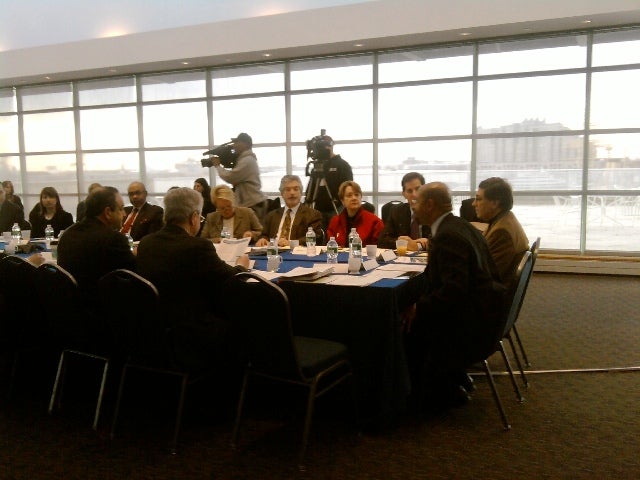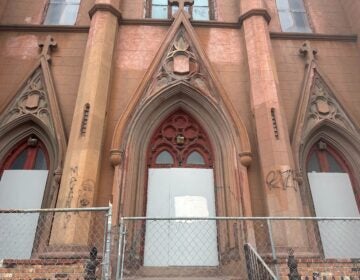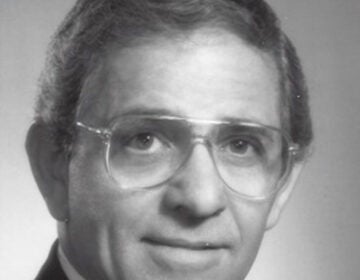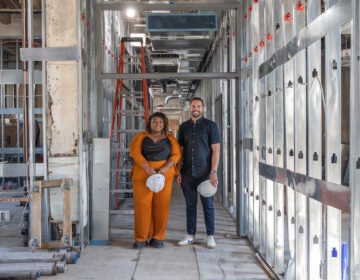DRWC has one year under its belt

First meeting of the Master Plan working group
Having recently closed out its first year in existence, the Delaware River Waterfront Corporation used its first annual meeting as a chance to highlight accomplishments.
Mayor Michael Nutter, created the DRWC last year on the same day he imploded its predecessor, the often criticized Penn’s Landing Corporation http://planphilly.com/node/7000. Penn’s Landing was seen as a behind-closed-doors operation that did not get much done on the waterfront. Nutter wanted its successor to move quickly toward improving the waterfront, and to do so with the public’s eyes upon it.
https://www.youtube.com/watch?v=XXIkcOzwBls
The organization’s biggest undertaking was hiring Cooper Robertson to create the master plan that will guide development between Oregon and Allegheny Avenues for decades to come http://planphilly.com/cooper-robertson-partners-team-plan-central-delaware. The DRWC made the hire, but they invited the public to hear presentations from the five finalists http://planphilly.com/delaware-river-master-plan-moment.
DRWC also awarded a design contract to James Corner Field Operations to create a new public park on the Race Street Pier – the space formerly known as Pier 11. The public was invited to view three design options, and their favorite design was chosen http://planphilly.com/race-street-pier-gets-slice-river-life.
https://www.youtube.com/watch?v=Xl0WHnJL-TI
At Friday’s meeting, Joseph Forkin, DRWC Vice President for operations and development announced a big step in the project that would turn Pier 53 into public space http://planphilly.com/rfp-issued-pier-53.
The contract was awarded to Biohabitats Inc. http://www.biohabitats.com/ndg_newsite/locations.php
Forkin said the company has done extensive work with the Philadelphia Water Department and the state Department of Conservation and Natural Resources. The company has five regional offices, including the one that DRWC will work with, in Baltimore. Forkin said to expect floating wetlands as well as a public area at Pier 53 when it’s finished, sometime this summer. According to their website, Biohabitats has done ecological conservation and restoration projects on rivers around the country.
https://www.youtube.com/watch?v=SoiOK3Fn09c
Nutter is pleased with the results. “In just one year, not only has DRWC achieved a great amount, but they have also done it with an unprecedented level of public and community engagement and have set us on a clear path to a vibrant, accessible waterfront that can be enjoyed by all Philadelphians,” he said in the printed report.
Other accomplishments listed in the report include convincing President Tom Corcoran to cross the Delaware (he used to be the president and CEO of the Cooper’s Ferry Development Association) http://planphilly.com/node/9653, naming Donn Scott chairman of the board, and hosting more events on the waterfront.
https://www.youtube.com/watch?v=0pS1zQYLvGk
The document presented did not include financial information. Corcoran said a separate financial report will be available in March or April when the audit is done. A decision still needs to be made about whether next year’s annual report will include financial information or if there will continue to be separate documents.
Penn School of Design Dean Marilyn Jordan Taylor, who lead the committee that chose the master plan team, said that while Year One was great, “Year two is going to be even better” because it will be spent developing the master plan. She then introduced key members of the team who will create the plan, and talk turned toward the future.
Nutter said their work, and that of the board, would be remembered in years to come as a turning point in the history of Philadelphia. “We’re talking about nothing short of the complete transformation of the city,” he said, and it will start on the waterfront.
Members of the master plan team – Alex Cooper from Cooper Robertson, Cindy Sanders from the Olin Partnership, James Timberlake from KieranTimberlake, and John Alschuler from HRA Advisors – gave overviews of the work each of their firms would be doing on the Master Plan.
Timberlake said their work would be informed by Greenworks Philadelphia – the city’s plan to become the most environmentally friendly city in the nation.
Alschuler, the economic guy on the team, said the city was literally built on its waterfront, and the waterfront of the future “needs to be a generator of jobs, of tax base and of quality of life.” Alschuler said in the end, the group would not be judged not so much by the plan they come up with, but by how much of the plan becomes reality.
Sanders talked about the need for both green space and civic gathering spots. And she spoke of using the Master Plan to help achieve city goals of increasing tree cover and improving access to local foods with community gardens and farmers’ markets.
Cooper, who is the leader of the master plan team, said team members have spent the past couple of weeks walking around and studying the area between Oregon and Allegheny Avenues and talking to some of the organizations who are interested in that land. These groups include the Central Delaware Advocacy Group, which is comprised of representatives from waterfront community associations and other organizations, and the Development Workshop, a non-profit that seeks to promote development in Philadelphia.
One key goal for the redevelopment of the waterfront is to reconnect it to the city’s neighborhoods. Cooper said the city’s vibrant and quirky waterfront and near-waterfront neighborhoods would be the envy of any city.
While I-95 is often scorned as the great barrier between the city and its eastern river, Cooper said there are actually many ways to get from the neighborhoods to the Delaware – if you’re driving.
“There are 70 streets that head to the waterfront, and 75 percent of them go through to the water, either under or over I-95,” he said. Twelve streets go over the highway and 40 beneath it, he said. “So for automobiles, there’s almost total access. It’s not so easy for pedestrians, however.”
DRWC Chairman Scott beamed from the podium after the team’s presentations. “If you want to know why the board is so excited about serving on the DRWC, this is an example,” he said. “We want to make this a reality.”
After the annual meeting, the team members and many others headed to DRWC headquarters for the first meeting of the Master Plan Working Group – representatives from city civic associations, non-profits, government and other sectors who are advising the team. They started the meeting by making similar presentations, video of which will be posted with that story.
During the public comment period at the end of the meeting, Paul Boni, a Society Hill resident who is the attorney for Casino-Free Philadelphia, said he was happy to receive an email notifying him of the annual meeting, but disheartened that he did not know about the Working Group meeting that followed. “I am concerned that, at least to my knowledge, the public at large was not given prior notification at least to come and observe,” he said. He suggested that the DRWC’s committee meetings should also be open to the public, and that there should be some sort of email notification to let interested people know when and where they were.
Afterward, Corcoran said that committee meetings would not be open to the public, but that steps are being taken to post summaries of what happens at each committee meeting. Corcoran said the DRWC was also looking for ways to better spread the word about its full meetings, which are open to the public. The meeting dates are posted on the DRWC website. http://www.delawareriverwaterfrontcorp.com/index.php?pageID=17&image=13
Ed Kirlin, who lives in Pennsport, said that Pennsport stakeholders were not notified of the Pier 53 RFT, and that they should have had input.
Matt Ruben, speaking as the vice chair of the Central Delaware Advocacy Group, praised the DRWC for having a much more open system than its predecessor. “A year and a day ago the public had no place to petition its government to talk about the land on its waterfront,” he said. “We are so pleased at the transparency.”
Switching roles, Ruben spoke as president of the Northern Liberties Neighbors Association and pleaded with the board to be sure that the master plan included a mixed use project with revenue-generating private development and “significant public space” at the former incinerator site.
Contact the reporter at kelliespatrick@gmail.com
Coverage of DRWC master planning session to follow
WHYY is your source for fact-based, in-depth journalism and information. As a nonprofit organization, we rely on financial support from readers like you. Please give today.






